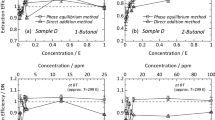Conclusions
-- The thermo-oxidative resistance of carbon fibres of the “Ural” type with a final temperature of heat treatment from 600 to 2400°C has been determined in the testing temperature range of 300–900°C in air.
-- It has been shown that with increase in the heat-treatment temperature, the oxidative resistance of the material is increased, and the effective activation energy of the oxidation process is raised, which is connected with the structural perfection of the carbon fibre.
-- The temperature ranges for use of fibres of the “Ural” grade having various final heat-treatment temperatures have been established.
Similar content being viewed by others
Literature cited
A. A. Konkin, Carbon and Other Heat-Resistant Fibrous Materials [in Russian], Khimiya, Moscow (1974).
S. Simamura (ed.), Carbon Fibres [Russian translation], Mir, Moscow (1987).
T. K. Mikhailova, S. G. Fedorkina, M. N. Goroshkova, Yu. V. Volkova, V. O. Gorbacheva, and A. A. Konkin, Summaries of Reports at the 8th All-Union Conference on Thermal Analysis, Moscow (1982), p. 166.
M. L. Yunitskaya, L. L. Kalacheva, et al., Khim. Volokna, No. 5, 59–60 (1989).
Additional information
Translated from Khimicheskie Volokna, No. 3, pp. 53–54, May–June, 1990.
Rights and permissions
About this article
Cite this article
Yunitskaya, M.L., Kalacheva, L.L., Shchaveleva, T.P. et al. Reactivity of carbonaceous fibre materials in air. Fibre Chem 22, 204–206 (1990). https://doi.org/10.1007/BF00548347
Issue Date:
DOI: https://doi.org/10.1007/BF00548347




